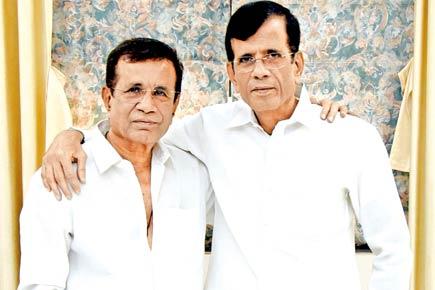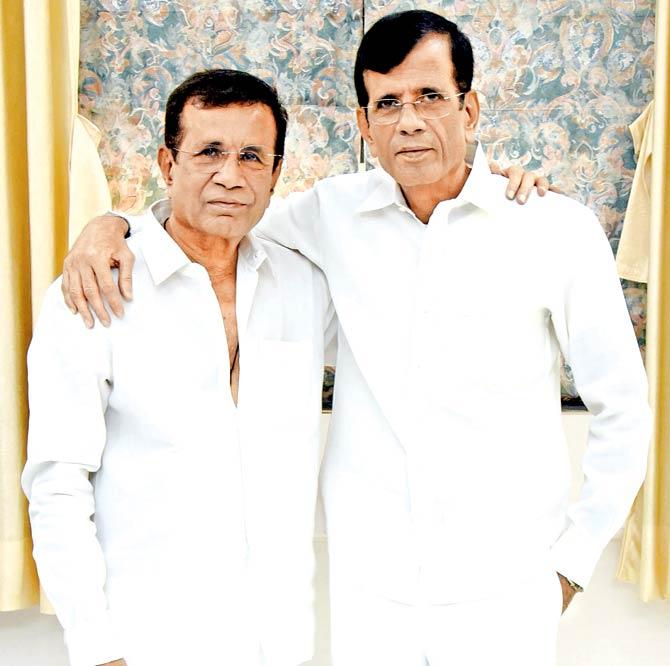Decoding director duo Abbas-Mustan’s dress code — the white shirt and trousers that's possibly India's most popular daily uniform too!

Directors Abbas and Mustan Burmawalla are well known for turning up everywhere, every day, in the same white shirt, white trousers, stitched from the same shop

Directors Abbas and Mustan Burmawalla are well known for turning up everywhere, every day, in the same white shirt, white trousers, stitched from the same shop
ADVERTISEMENT
All Indians, indirectly or directly, are Reliance consumers. But filmmakers Abbas-Mustan have a special fondness for Reliance. It's a tailoring shop, off Opera House, that they've been going to for quarter of a century. It's close to Mohammed Ali Road, where Burmawalla brothers — directors Abbas, Mustan (who never shout 'action' during shoots), and Hussain, who edits their films — grew up. They moved to Lokhandwala 18 years ago, to live and make movies together.
One of Abbas-Mustan's significant contributions to Bollywood is they gave us Shah Rukh Khan. Baazigar (1993) possibly counts as SRK's first major hit as solo lead. Baadshah, the epithet attached to the superstar's name, is as a result of a 1999 Abbas-Mustan film.
Beyond that, Burmawalla Bros, over 25 years, are well known for turning up everywhere, every day, in the same white shirt, white trousers, stitched from the same shop. They claim to rotate between only four sets of clothing. It's my Delhi Public (and surely other kids') school uniform — including white shoes, on sports day.
Even if you weren't surveying a room at eye-level, it'd be impossible to miss Abbas-Mustan in a casual glance. This is how I spotted them at a wedding reception recently, joined them for a few drinks, while guests interrupted us to click selfies, and asked the same question that I had: "Sir! What's with the white?" "Just. It makes life simpler," Abbas, Mustan, or Hussain replied, taking turns.
In their fondness for white, Abbas-Mustan aren't alone. Most Indian politicians, chiefly from the Congress-combine, wear white (kurta, pyjama/dhoti). It is the traditional politician's official uniform, perhaps picked initially to register their allegiance to Mahatma Gandhi, the freedom movement, and the khadi. Certain members of the BJP, often deeply critical of Gandhi, are more into regular middle-class wear — sometimes brighter colours; of late, the sleeveless jacket. Perhaps being more 'Hindu' than others, they relate white attire with Hindu funerals. The same colour is dress code for joyous Christian weddings.
Several of them still opt for white as daily professional wear. The colour nailed to the mast is a call for truce; on the Indian flag, it signifies peace and truth. In heraldry (coat of arms), white depicts faith and purity. All these qualities ought to help a politician come across as Mr Clean. Trust is important, which possibly makes the staid white shirt also the unchanging standard fare among corporates worldwide.
If I was poor, I'd be envious of the Indian politician, knowing that their white kurta, or shirt, remains starched clean at the end of a long day. It automatically denotes a life of sedentary, air-conditioned comfort, rather than the coarseness, heat and dust of the regular working-class day.
The white, in that sense, could also subtly indicate an upper-class upgrade among sub-altern aspirants. Who knows? I'm half-sure it did for producers down South, who merrily passed on their sparkling white shirt-trousers-shoes fetish to Jeetendra in the '80s.
If I was him, I'd be perennially cautious of Murphy's law on the white shirt. Which, quite simply, is that if you're wearing one, something at some point, will fall on it. I'd already dropped a bit of coffee on my white shirt today — before sitting down to write this. I hope, coming up next isn't red wine.
Would I still wear one tomorrow? Maybe, since function ought to trump fashion sometimes. The white, especially the dhoti (in North India), and the mundu (in the South), with its private ventilation system, makes sense when there are only two possible weather types — hot, and hotter. People still prefer jeans or trousers in cities, I suspect, because the mundu marks you out as a bumpkin.
The kurta, similarly, is best designed to endure heat, and even hide the inevitable, male, middle-age paunch. Its female equivalent is probably the saree — as against the western 'dress' — exposing some parts of the body, covering certain others, perfectly accentuating just the right curves. Only the relatively rich, used to being indoors, can afford to shed a few kilos, by just putting on a black dress/shirt.
But that's separate from Abbas-Mustan's love for white. What they mean by keeping it simple is getting rid of the headache of finding a new pair of clothes to be photographed at yet another event. No fashion police is going to charge them with repeating what they wore last night. Politicians and boardroom Brahmins, establishing a fashion consensus, similarly diminish any possibility of a sartorial disaster. You may not wish to needlessly stand out, when so much else is at stake.
Abbas-Mastan stand out. I'm sure they would have a cleverer answer for a question they've been asked every day for 25 years. "It's because we don't like darkness of any kind — in our life, or films. Our white clothes reflect that," thriller director Mustan Bhai tells me. "Once Saif (Ali Khan) wanted to shoot at night for Race (2008). We told him, we don't shoot at night!"
Mayank Shekhar attempts to make sense of mass culture. He tweets @mayankw14 Send your feedback to mailbag@mid-day.com
 Subscribe today by clicking the link and stay updated with the latest news!" Click here!
Subscribe today by clicking the link and stay updated with the latest news!" Click here!






